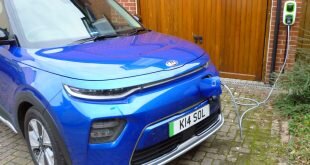Tackling the electric car charging challenge

By 2030, sales of new cars and vans powered wholly by petrol and diesel will be banned, with hybrids to follow five years later.
Between now and then most new cars launched will be offered with some form of electrification, accelerating demand for charge points.
As a motoring journalist I test-drive as many as 100 new cars every year. However, living in the South West I’ve found that chargers are few and far between, meaning that a home solution is a necessity.
I can currently count on one hand the number of home charge points in my village, while the nearest public charger is four miles away at a service station.
Which is why my smart new Rolec WallPod:EV home charger is just the job, allowing me to charge pure electric vehicles (EVs) and plug-in hybrids (PHEVs) overnight.
With more than 10 years of experience in the EV industry, Rolec provides charging solutions for the home, commercial locations, workplaces and fleets and has more than 50,000 in use across the country.
Ordering a Rolec WallPod:EV home charger couldn’t have been simpler. First, Rolec referred me to its nearest approved installer (SVE Electric Services, based in Bristol) who carried out a quick on-site survey to determine my preferred location and to check the electricity supply.
Rolec then asked me to choose from one of 24 colour combinations for my WallPod. Once that was done, SVE were back with my charger within a week and it was installed in around two hours.
Then it was just a case of connecting the Kia Soul EV I was driving that week (one of the most affordable long-range electric cars on the market) via a Type 2 cable) and the charging could begin.
Eligible for OLEV (Office for Low Emission Vehicles) grant funding under the Electric Vehicle Homecharge Scheme (EVHS), the Rolec WallPod:EV home charger is easy-to-use, stylish, weatherproof and hard-wearing – an ideal entry-level electric car charging solution.
However, there’s still a massive charging infrastructure challenge. A recent report by the Policy Exchange think-tank said the UK will need 400,000 public chargers by 2030, up from 35,000 currently.
Then there’s the issue of where to locate chargers. I’m lucky because I have a garage with off-street parking, but it’s a different matter for motorists living in flats and terraces, for instance.
Transport Secretary Grant Shapps has announced a further £20m of funding for local authorities to install 4,000 more on-street charge points across the UK.
These will allow residents without access to off-street parking to charge their vehicles, but it’s still a drop in the ocean.
Additionally, the Department for Transport (DfT) says EVHS, which provides up to £350 towards a charge point, will continue in 2022 and be expanded to target people in rented and leasehold accommodation.
At the same time, the Workplace Charging Scheme (WCS) will be opened up to small to medium enterprises and the charity sector. The changes will also mean that accommodation businesses, such as B&Bs, can benefit from the funding, boosting rural areas.
So, there is hope, but it’s a race against time. Oh, and I haven’t even tackled the issue of how the electricity will be generated.
- For more details of Rolec EV chargers
- Info and contact details for SVE Electric Services

